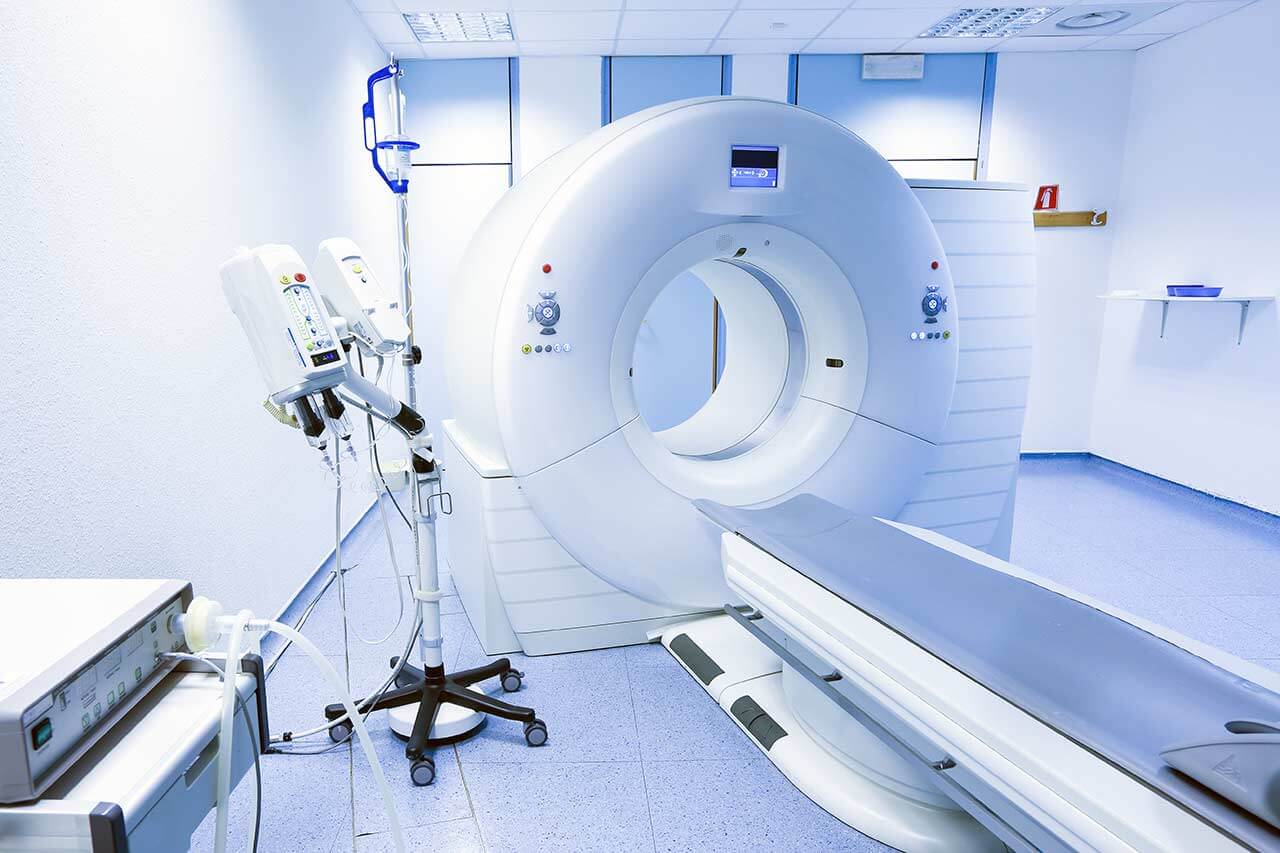
The program includes:
- Initial presentation in the hospital
- Clinical history taking
- Review of available medical records
- Physical examination
- Laboratory tests:
- Complete blood count
- General urine analysis
- Biochemical analysis of blood
- Tumor markers
- Inflammation indicators (CRP, ESR)
- Coagulogram
- Ultrasound scan
- CT scan / MRI
- Preoperative care
- Embolization or chemoembolization, 2 procedures
- Symptomatic treatment
- Cost of essential medicines
- Nursing services
- Elaboration of further recommendations
How program is carried out
During the first visit, the doctor will conduct a clinical examination and go through the results of the available diagnostic tests. After that, you will undergo the necessary additional examination, such as the assessment of liver and kidney function, ultrasound scan, CT scan and MRI. This will allow the doctor to determine which vessels are feeding the tumor and its metastases, as well as determine how well you will tolerate the procedure.
Chemoembolization begins with local anesthesia and catheterization of the femoral artery. The thin catheter is inserted through a few centimeters long incision of the blood vessel. The doctor gradually moves the catheter to the vessel feeding the primary tumor or its metastases. The procedure is carried out under visual control, an angiographic device is used for this. The vascular bed and the position of the catheter in it are displayed on the screen of the angiograph.
When the catheter reaches a suspected artery, a contrast agent is injected through it. Due to the introduction of the contrast agent, the doctor clearly sees the smallest vessels of the tumor and the surrounding healthy tissues on the screen of the angiograph. After that, he injects emboli into the tumor vessels through the same catheter.
Emboli are the spirals or the liquid microspheres. The type of embolus is selected individually, taking into account the diameter of the target vessel. When carrying out chemoembolization, a solution of a chemotherapy drug is additionally injected into the tumor vessel. Due to the subsequent closure of the vessel lumen with an embolus, the chemotherapy drug influences the tumor for a long time. In addition, the drug does not enter the systemic circulation, which allows doctors to use high doses of chemotherapeutic agents without the development of serious side effects. Chemoembolization leads to the destruction of the tumor or slowing down its progression.
After that, the catheter is removed from the artery. The doctor puts a vascular suture on the femoral artery and closes it with a sterile dressing. During chemoembolization, you will be awake. General anesthesia is not used, which significantly reduces the risks of the procedure and allows performing it on an outpatient basis, avoiding long hospital stay.
After the first procedure, you will stay under the supervision of an interventional oncologist and general practitioner. If necessary, you will receive symptomatic treatment. As a rule, a second chemoembolization procedure is performed in 3-5 days after the first one in order to consolidate the therapeutic effect. After that, you will receive recommendations for further follow-up and treatment.
Required documents
- Medical records
- MRI/CT scan (not older than 3 months)
- Biopsy results (if available)
Service
You may also book:
 BookingHealth Price from:
BookingHealth Price from:
About the department
The Department of Adult and Pediatric Diagnostic, Interventional Radiology at the University Hospital Heidelberg offers the full range of services in these medical fields. It conducts all modern radiological examinations and imaging-guided minimally invasive interventions for the treatment of various benign and malignant diseases. A feature of the department is imaging diagnostics in children and adolescents. There are specially adapted devices with minimal irradiation for this purpose. The Chief Physician of the department is Prof. Dr. med. Hans-Ulrich Kauczor.
The work of the department is based on the picture archiving and communication system, which allows the doctors to save patients’ examination results and provide access to the specialists from other departments of the hospital.
The medical staff of the department consists of the best professionals in their field, who have been educated at the prestigious universities in Germany, Europe and America. The specialists of the department regularly undergo advanced training courses, so they are keeping abreast of the very latest scientific achievements in medicine. In addition, many doctors are actively involved in the department’s research activities.
The service range of the department includes:
Diagnostic radiology
- Angiography and digital subtraction angiography
- Computed tomography
- Magnetic resonance imaging
- Fluoroscopy
- Mammography
- MR mammography
- Tomosynthesis
- Galactography
- Combined PET-CT examination method (in collaboration with the Department of Nuclear Medicine)
- Conventional X-ray examinations
- Sonography (echography, ultrasound examinations) and color doppler/duplex sonography
- Other diagnostic methods
Pediatric radiology
- X-ray examinations
- Ultrasound examinations
- Magnetic resonance imaging
- Other diagnostic examinations in children
Interventional radiology
- All vascular interventions (except for heart and brain vessels)
- Balloon catheter implantation
- Balloon dilatation
- Angioplasty
- Stent implantation
- Interventional procedures for the treatment of tumors of the liver, musculoskeletal system (bones), kidneys, and blood vessels
- Radiofrequency ablation
- Selective internal radiation therapy
- Transarterial chemoembolization
- Uterine artery embolization for the treatment of uterine myomas
- All emergency imaging-guided interventions (for example, closing of vessels in acute haemorrhage and blood clot removal; except for heart and brain vessels)
- Transjugular intrahepatic portosystemic shunting for the treatment of severe portal hypertension
- Imaging-guided biopsy (for example, bone tissue biopsy, vacuum and puncture breast biopsy)
- Other interventional procedures
Curriculum vitae
- 1983 - 1989 Study of Medicine at the University of Bonn (Germany), Internship, University of Heidelberg, (Germany), Final Medical Examination (Doctor of Medicine).
- 1989 - 1994 Residency in Radiology, German Cancer Research Center (DKFZ) Heidelberg and University of Mainz, Germany, Board Certification for Diagnostic Radiology.
- 1994 - 1995 Fellowship, Department of Radiology, University of Mainz, Germany.
- 1996 - 1998 Assistant Professor, Department of Radiology, University of Mainz, Germany.
- 1998 Postdoctoral Qualification as University Lecturer at the University of Mainz "Functional Imaging of Lung Ventilation using CT and MRI".
- 1998 - 2002 Assistant Professor in the Department of Radiology, University of Mainz, Germany.
- 2003 - 2010 Member of the Board of Managing Directors of the Comprehensive Cancer Center Heidelberg, Germany.
- 2003 - 2008 Full Professor for Radiology, Head of the Department of Radiology at the German Cancer Research Center (DKFZ), Heidelberg, Germany.
- Since 2008, Full Professor and Head of the Department of Adult and Pediatric Diagnostic, Interventional Radiology at the University at the University Hospital Heidelberg.
- Since 2012 Principal Investigator of the Translational Lung Research Center Heidelberg (TLRC) and the German Center for Lung Research (DZL).
Awards and Honors
- 1992 Award of the German Society of Radiology.
- 1995 Award of the European Society of Thoracic Imaging.
- 1999 Boehringer Ingelheim Award.
- 1999 Colloquia Academica of the Academy of Science of Literature Mainz.
- 2000 Holthusen-Ring of the German Society of Radiology (DRG).
- 2001 Award of the Society of Thoracic Radiology.
- 2007 Kuhrt-Robb Award for the Distinguished Scholar of the Memorial Sloan Kettering Cancer Center, New York.
- 2012 Visiting Professor, Medical College of the Qingdao University, China.
Photo: (с) depositphotos
About hospital
According to Focus magazine, the University Hospital Heidelberg ranks among the top five hospitals in Germany!
The hospital is one of the most advanced and reputable medical institutions not only in Germany but throughout Europe. There are more than 43 specialized departments and 13 medical institutes which cover all fields of modern medicine. A distinctive feature of the hospital is the presence of unique therapeutic methods for the treatment of complex and rare clinical cases.
Due to successful clinical practice, the hospital has been holding leading positions in the international medical arena for many years. The basis for this popularity is the combination of the very latest technologies, competent specialists, and active research activities, which allows introducing of revolutionary diagnostic and treatment methods, which save lives.
In addition to the outstanding medical achievements, it is worth noting a particularly friendly and pleasant atmosphere, and respectful attitude towards the patient. Both doctors and nursing staff make every effort to meet all the needs and wishes of the patient, pay due attention to each clinical case, and have personal communication with the patient, which contributes to a positive treatment result.
Photo: (с) depositphotos
Accommodation in hospital
Patients rooms
The patients of the University Hospital Heidelberg live in comfortable single and double rooms designed in bright colors. Each room is equipped with an ensuite bathroom with a shower and toilet. The patient rooms are quite spacious, they have a table with chairs for receiving visitors. Roomy wardrobes are provided for storing personal belongings. It is possible to connect to the Internet. In addition, the hospital offers enhanced-comfort rooms with a safe, refrigerator, and upholstered furniture. Patients have 24-hour access to the services of medical personnel.
Meals and Menus
The patient and his accompanying person have a daily choice of three menus. If you for some reason do not eat all the products, you will be offered an individual menu. Please inform the medical staff about your dietary preferences prior to the treatment.
Further details
Standard rooms include:
Religion
The religious services are available upon request.
Accompanying person
During the inpatient program, an accompanying person may stay with you in a room or hotel of your choice.
Hotel
During the outpatient program, you may live in a hotel of your choice. The managers will help you choose the most suitable options.
The hospital offers a full range of laboratory tests (general, hormonal, tests for infections, antibodies, tumor markers, etc.), genetic tests, various modifications of ultrasound scans, CT scans, MRI and PET / CT, angiography, myelography, biopsy and other examinations. Treatment with medications, endoscopic and robotic operations, stereotaxic interventions is carried out here, modern types of radiation therapy are also used. The hospital offers patients all the necessary therapeutic techniques.
- Endovascular treatment of liver pathologies with LigaSureTM, Ultracision® and Habib®-Sealer devices
- Correction of chest deformities in children (Nass operation)
- Minimally invasive direct coronary artery bypass grafting
- Replacement of ascending aorta (David procedure)
- Operations using the da Vinci robotic system
These are primary lung tumors and metastases in the lungs, benign and malignant liver pathologies, thyroid pathologies, gastroesophageal reflux disease, heart rhythm disturbances and heart failure, infertility, fibromyalgia, damages and pathologies of large joints, polyneuropathy and other diseases.
- Thoracic surgery
- Cardiac surgery
- Urology
- Orthopedics and traumatology
- Obstetrics and gynecology
The hospital's team consists of more than 13,000 highly qualified employees




